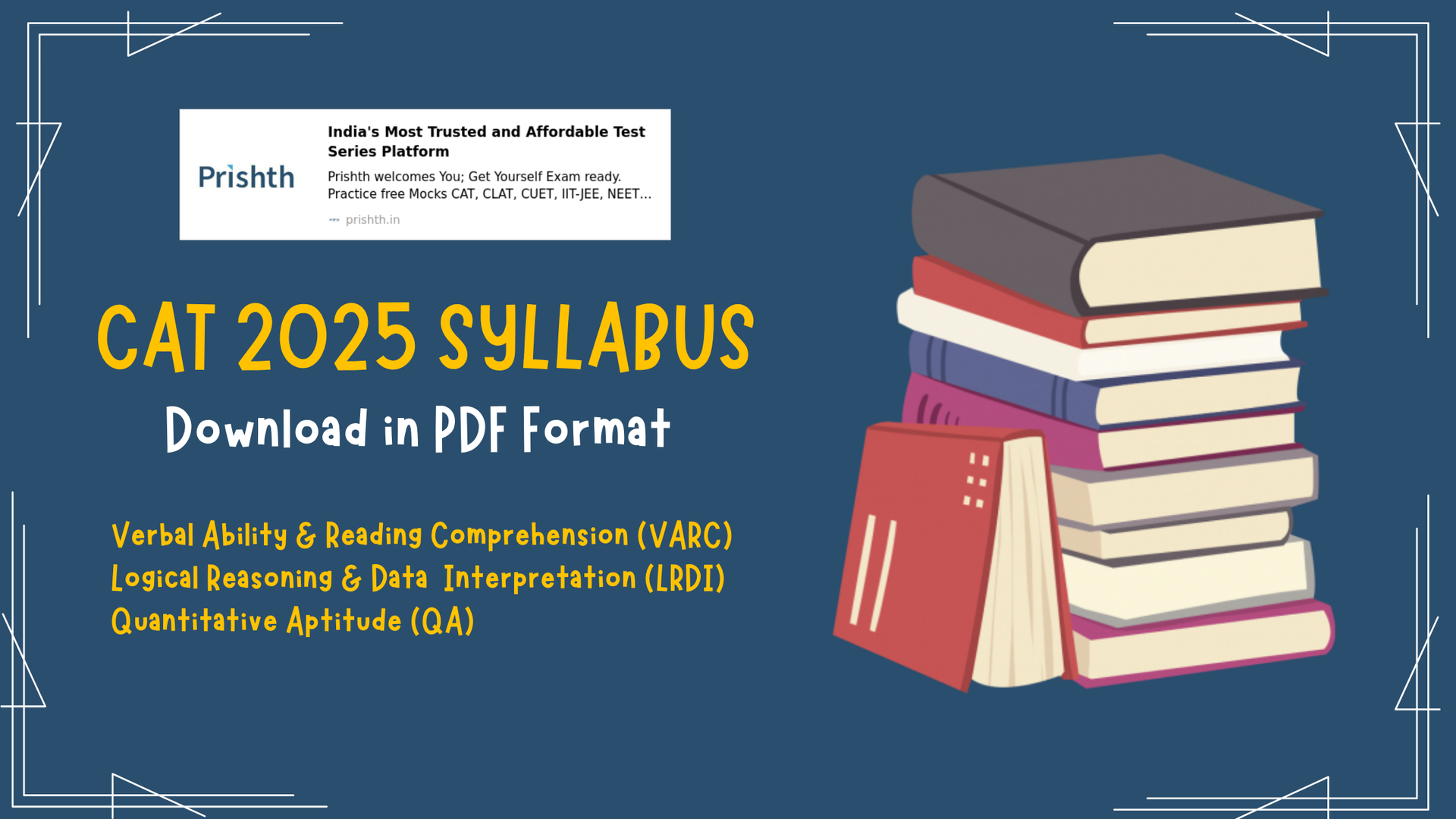CAT Syllabus: Section wise detailed syllabus (Download in PDF Format)

What Is the CAT Exam
The Common Admission Test (CAT) is one of the most prestigious management entrance exams in India. Conducted annually by the Indian Institutes of Management (IIMs), it opens doors to elite MBA programs. CAT is not just an exam; it’s a gateway to a transformative career in business management, making it a top choice for ambitious graduates.
Every year, over 2 lakh students appear for CAT, competing fiercely for limited seats. Its competitive nature stems from the high stakes involved, as CAT scores are accepted by premier institutions like IIMs, FMS Delhi, SPJIMR Mumbai, and many others.
If you're dreaming of an MBA, the CAT exam is your golden ticket. Let’s dive deep into
CAT Syllabus and learn everything you need to know to ace the CAT Exam
Understanding the CAT Exam Structure
The CAT exam is a computer-based test (CBT) with three sections:
| Section | Number of Questions | Marks | Duration (minutes) |
|---|---|---|---|
| Verbal Ability & Reading Comprehension (VARC) | 24 | 72 | 40 |
| Data Interpretation & Logical Reasoning (DILR) | 22 | 66 | 40 |
| Quantitative Ability (QA) | 22 | 66 | 40 |
| Total | 68 | 204 | 120 |
Marking Scheme:
- +3 marks for every correct answer.
- -1 mark for incorrect answers (MCQs).
- No negative marking for non-MCQ (TITA) questions.
Time management is crucial since each section is timed, and switching between sections isn’t allowed.
Detailed CAT Exam Syllabus
Let’s dive into CAT Exam syllabus and understand the topics that form the core of CAT preparation. The CAT Exam is divided in three sections as discussed above; Let's check the CAT Exam syllabus of each section in detail:
1. Verbal Ability & Reading Comprehension (VARC) Syllabus
VARC is designed to test your comprehension and analytical skills, along with your command over English grammar and vocabulary. This section accounts for approximately one-third of the total score.
Total Questions in the VARC section is 26 (16 reading comprehension, 8 Verbal Ability).
The are
five types of questions asked in the VARC section of CAT Exam, Reading Comprehensions, Summary Questions, Para Jumbles, Odd Sentence Out, Para Completion. Let's, check syllabus of each type of Questions asked in CAT VARC Section:
1.1 Reading Comprehension (RC):
When we talk about Reading Comprehension in CAT, forget about those simple passages you might remember from school. These passages are more like what you'd encounter in a thought-provoking journal or an analytical business report. You'll find yourself reading about everything from economic theories to scientific discoveries, from social issues to philosophical debates.
What makes this tricky? Well, the questions have evolved. They're not just asking "what did the author say?" anymore. Instead, they want to know what you think about what the author said. It's like being in a discussion where you need to read between the lines and understand the deeper implications.
Genres of Passages on which question are asked in Reading Comprehension of CAT Exam:
- Business / Economics
- Environment
- Science and Technology
- History
- Arts and Culture
- Philosophy/ Psychology
- Society and Politics
Types of Question asked in CAT Reading Comprehension Questions:
- Main Idea Questions.
- Inference-Based Questions.
- Strengthen or Weakening Questions.
- Detail-Based Questions.
- Vocabulary-Based Questions.
- Tone and Style-Based Questions.
- Purpose and Function-Based Questions.
- Structure-Based Questions.
- Assumption-Based Questions.
- Suitable Topic.
Remember:
CAT RC is not just about reading speed - it's about deep understanding and analytical ability. The key is to practice regularly with high-quality passages and develop a systematic approach to different question types.
1.2
Para Summary Questions:
Identify the most accurate summary for a passage. Summary questions are among the most intellectually demanding tasks in the CAT VARC section.
Here, you’re presented with
a brief passage, typically 80-100 words long, followed by
four potential summaries.
These questions require you to extract the essence of the passage—its primary argument—and choose the option that captures its core meaning without introducing inaccuracies or superfluous details.
Mastering this requires identifying irrelevant or exaggerated elements in the options and isolating the choice that stays true to the passage’s scope and tone. The options are carefully crafted to test your comprehension at multiple levels:
- Some options may capture 90% of the passage correctly but add a small, unsupported inference
- Others might omit a crucial qualifier or condition from the original argument
- A few might rephrase the ideas in a way that slightly alters their relationship or importance
- The correct option often appears less appealing at first glance because it maintains the nuanced position of the original text
1.3
Para Jumbles Questions:
In Para Jumbles questions asked in CAT you have to rearrange sentences to form a coherent paragraph (TITA).
Usually TITA (Type in The Answer) questions are asked in the Para jumbles of the CAT Exam, there is absolutely no margin for error. In the Para jumble questions usually 4-5 sentences are given out of order. These sentences when arranged in a logical way together, they form a coherent paragraph.
To solve these questions correctly start by identifying the first sentence (introduces the topic) and the last sentence (concludes or makes a judgment).
Then you can arrange the middle sentences logically to form a seamless flow.
1.4 Odd- Sentence Out:
In the Odd Sentence Out questions asked in CAT we have t0 spot the sentence that doesn’t fit within a paragraph (TITA).
Odd sentence out are also TITA questions. Among 4-5 sentences, identify the one that doesn’t fit within the logical flow of the paragraph.
1.5 Para Completion:
Para Completion type is where a part of the paragraph is missing, and you must select the most logical sentence to complete it. Para completion questions test a candidate's ability to maintain logical and thematic consistency in a given passage.
While solving the Para Completion Questions, students should avoid selecting options that introduce new themes; Choosing conclusions that are too extreme or picking options that contradict earlier statements or Selecting answers based on specific words rather than overall meaning.

2. Data Interpretation & Logical Reasoning (DILR) Syllabus
The DILR section of CAT Exam represents the most dynamic and challenging component of the examination. Unlike other sections that draw from traditional academic syllabi, DILR tests candidates' ability to process and analyze information in various formats while applying logical reasoning skills to solve complex problems. Lets check what is in the
syllabus of DILR section :
2.1 Data Interpretation (DI):
Caselets: Short paragraphs with data-based questions.
Graphs and Charts: Includes bar graphs, line graphs, and pie charts.
Tables: Tabular data requiring calculations and inferences.
Combination Sets: Problems involving multiple data formats.
2.2 Logical Reasoning (LR):
Puzzles:
Problems involving arrangements, grouping, and distribution.
Seating Arrangements: Linear, circular, and grid-based setups.
Family Trees: Relationship-based questions.
Games and Tournaments: Analyze rankings and schedules.
Routes and Network

3. Quantitative Aptitude (QA)
Quantitative Aptitude evaluates your mathematical prowess and problem-solving skills. A good grasp of concepts is essential for tackling this section.
3.1 Arithmetic (35% Weightage)
Arithmetic deals with basic mathematical operations and their applications in real-world problems. It includes:
- Numbers and Operations:
Factorials, Fractions, Divisibility Rules, HCF & LCM, Remainders, Base Systems, Calendars
- Commercial Mathematics:
Ratio and Proportion, Partnership, Percentage, Profit and Loss, Simple and Compound Interest, Installments
- Applied Mathematics:
Time and Work, Pipes and Cisterns, Time, Speed and Distance, Trains and Boats, Races (Linear and Circular), Clocks
3.2 Algebra (30% Weightage)
Algebra focuses on the study of symbols and rules for manipulating them. It includes:
- Basic Concepts:
Polynomials, Functions, Modulus, Exponents & Powers, Logarithms, Binomial Expansion.
- Equations: Linear, Quadratic, Higher Degree, Word Problems, Age-related Problems Advanced.
- Topics:
Sequences and Series, Inequalities, Maxima and Minima, Graphs, Greatest Integer Function.
3.3 Geometry (20% Weightage)
Geometry in CAT Exam tests spatial reasoning and visualization skills:
- 2D Geometry:
Triangles, Quadrilaterals, Circles, Coordinate Geometry, Properties of geometric centers
- 3D Geometry: Cubes, Cuboids, Cone, Cylinder, Sphere, Prism, Pyramid
3.4 Modern Mathematics (15% Weightage)
Modern Math involves topics requiring logical reasoning and abstract thinking:
- Permutations and Combinations: Arrangements, Selections, Distributions, Letter Arrangements, Geometric Arrangements
- Probability:
Basic Concepts, Conditional Probability, Bayes Theorem
- Set Theory: Basic Operations, 2-Set Problems, 3-Set Problems
How to Prepare for CAT Exam
Preparation is the backbone of CAT success. Here’s how to go about it:
1. Effective Study Plans
- Devote at least 4-6 hours daily for preparation.
- Focus on weak areas first while maintaining strengths.
- Divide your time between learning concepts and practicing problems.
2. Resources and Books to Use
- QA: “How to Prepare for Quantitative Aptitude for the CAT” by Arun Sharma
- VARC: “Word Power Made Easy” by Norman Lewis
- DILR: “Logical Reasoning and Data Interpretation for the CAT” by Nishit K. Sinha
3. Mock Tests: A Game-Changer
- Start with 1-2 mocks per week, increasing frequency as the exam nears. Analyze your mistakes and refine your approach for better scores.

Top CAT Preparation Tips from Toppers
Learning from those who’ve aced the exam is a smart way to streamline your preparation.
1. Insider Insights
- Start early to cover the entire CAT Exam syllabus without last-minute stress.
- Focus on accuracy over attempting more questions to minimize negative marking.
- Regularly revise basic concepts to build a strong foundation.
2. Mistakes to Avoid
- Don’t rely solely on shortcuts; understand the logic behind concepts.
- Avoid skipping mocks due to fear of poor performance—it’s part of the learning process.
- Overloading with too many resources can confuse rather than clarify.
Following these practical tips can give you the edge needed to outperform competitors.
How to Approach the CAT Syllabus
This section will guide you on how to systematically tackle the CAT syllabus to ensure balanced and effective preparation for all sections.
1. Set Weekly Targets:
- Break down each topic into smaller sections. For example, in QA, spend one week mastering arithmetic before moving to algebra.
2. Time Allocation:
- Suggested daily schedule: QA (2 hours), VARC (1.5 hours), DILR (1.5 hours).
- Allocate additional time to weaker areas as you progress.
3. Use a Phased Approach:
- Phase 1: Build conceptual clarity in all sections.
- Phase 2: Focus on solving topic-specific questions.
- Phase 3: Take full-length mock tests and refine strategies.
4. Analyze Mock Tests:
- Spend as much time analyzing mocks as taking them. Identify accuracy rates and time-consuming sections.
5. Incorporate Revision:
Dedicate one day per week solely to revising past topics and solving errors from mock tests.
Common Mistakes in CAT Preparation
It’s easy to make mistakes, but avoiding them can significantly enhance your preparation.
1. Ignoring Mock Analysis
- Mock tests without thorough analysis don’t help. Understand what went wrong and focus on weak areas.
2. Overlooking non-MCQs
- Since these questions have no negative marking, they can be scoring opportunities. Don’t leave them unanswered.
3. Neglecting VARC
- Many students focus heavily on quant and reasoning, sidelining VARC. A balanced approach is vital to excel in all sections.
4. Not Adhering to the syllabus
- Many students neglect the syllabus, the weightage applied to each section. Knowing how much time to be allotted to each section helps in smart study.
Awareness of these pitfalls can save valuable preparation time and effort.

Conclusion
CAT Exam is a test of not just knowledge but strategy and perseverance. With a clear understanding of the syllabus and consistent practice, you can achieve your dream of joining a top B-school. Start preparing today, and remember, success comes to those who work smart and stay focused.



